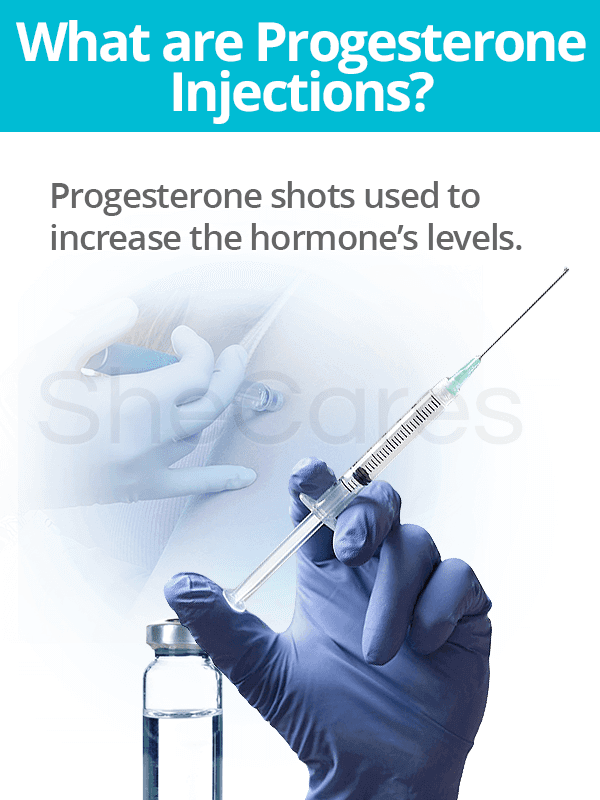Progesterone creams and progesterone pills are among the various popular treatments available for women who need an extra hormone boost. However, among the lesser used are progesterone shots.
Continue reading to learn more about the fundamentals of progesterone shots, including what they are used for, how and when they are administered, and more crucial information necessary to advance your hormonal health.
What are Progesterone Injections?
Progesterone injections are composed of synthetic progesterone - progestin - that acts as the endogenous hormone in a woman's body, thus treating a hormone deficiency.
What do Progesterone Injections Do?

In nonpregnant women, progesterone injections are used in order to stimulate menstruation in those with amenorrhea (absence of periods); treat abnormal uterine bleeding; act as birth control shots by stopping ovulation; and relieve symptoms of premenstrual syndrome (PMS) and premenstrual dysphoric disorder (PMDD).
In regard to pregnancy, progesterone shots are used to help reduce a woman's risk for premature birth and for luteal support during IVF treatment. Conflicting research is found on the shot's usefulness in preventing the occurrence of recurrent miscarriage or preterm birth.1,2
Progesterone Injection Benefits
In general, progesterone shots are used to manage hormonal disorders and treat their symptoms. These symptoms include, but aren't limited to:

- Breast tenderness
- Mood swings
- Irritability
- Insomnia
- Headaches and migraines
- Depression
- Hot flashes
- Bloating
- Anxiety
- Dizziness
- Irregular periods (more frequent, spotting between, etc.)
- Food cravings
- Poor concentration
- Diarrhea or constipation
- Gastrointestinal upset
How and When to Use a Progesterone Injection
How Do I Take a Progesterone Injection?
A progesterone shot is generally injected directly into a muscle by a doctor or nurse. Injection sites are rotated between the buttocks, upper leg, or upper arm so as to avoid problem areas in the muscles.
When Do I Use a Progesterone Injection?

For hormonal disorders, there are varying injection schedules depending on usage. For instance, they are usually taken every six to eight consecutive days to treat amenorrhea or abnormal uterine bleeding.
For birth control, progestin-only shots are injected once every three months, or four times a year. Combination progesterone shots, on the other hand, consisting of estrogen and progestin are administered monthly.
Furthermore, in cases concerning pregnancies, the exact treatment schedule will also be based on the reason for using the injection. For example, women who use the progesterone injections to prevent a miscarriage will do so starting in the second trimester on a weekly basis until parturition.
Progesterone Injection Side Effects

It is important to advise your doctor if you have any of the following medical conditions before treatment: epilepsy, asthma, kidney or heart disease, a history of depression, diabetes, or migraine headaches.
Some mild side effects include pain and swelling at the injection site, nausea, drowsiness, dizziness, headaches, breast tenderness or lumps, excessive hair (hirsutism), frequent or painful urination, abdominal pain, unusual vaginal bleeding or discharge, and weight fluctuations from edema, among others.
For specific use, progesterone injections are not often recommended during the first trimester of pregnancy due to the possible risk of fetal harm. After birth, the drug may pass into breast milk.
More severe side effects of using progesterone injections include risk of blood clots, strokes, severe allergic reactions, alopecia, slurred speech, vision changes, fainting, confusion, weakness on side of the injection site, and more.
Where Do I Buy Progesterone Injections?
Progesterone shots can be acquired with a doctor's prescription or over the counter at pharmacies. For proper usage, over-the-counter progesterone injections and their appropriate dosages should be discussed with a doctor.
Key Takeaways
Overall, progesterone injections can be used for many of the same reasons as other progesterone treatments - birth control, menstruation stimulation, etc. Nevertheless, it is widely favored for infertility and pregnancy usage. These shots are administered into muscles on a rotating schedule, which is dependent upon the medication's purpose. Mild side effects such as nausea, dizziness, and drowsiness are some of the many that can occur along with more severe side effects, such as blood clots. Use progesterone injections under supervision of a doctor for best results.
To avoid the possibility of severe health consequences with pharmaceuticals, continue reading to learn more about natural progesterone supplements that include the use of herbal treatments.
Sources
- Center for Young Women's Health. (2016). Estrogen/Progestin Hormonal Injections. Retrieved December 6, 2019, from https://youngwomenshealth.org/2011/07/01/hormonal-injections/
- Indiana University Bloomington Health Center. (n.d.). What is PMS/PMDD? Retrieved December 6, 2019, from http://healthcenter.indiana.edu/answers/pms.shtml
- Lim, A.C. et al. (2007). Progesterone for the prevention of preterm birth in women with multiple pregnancies: the AMPHIA trial. BMC Pregnancy & Childbirth, 7, 7. doi: 10.1186/1471-2393-7-7
- Planned Parenthood. (n.d.). Birth Control Shot. Retrieved December 6, 2019, from https://www.plannedparenthood.org/learn/birth-control/birth-control-shot
Footnotes:
- Coomarasamy, A. et al. (2015). A Randomized Trial of Progesterone in Women with Recurrent Miscarriages. The New England Journal of Medicine, 373, 2141-2148. Retrieved December 6, 2019, from http://www.nejm.org/doi/full/10.1056/NEJMoa1504927
- March of Dimes. (2014). Progesterone Treatment to Help Prevent Premature Birth. Retrieved December 6, 2019, from https://www.marchofdimes.org/complications/progesterone-treatment-to-help-prevent-premature-birth.aspx
